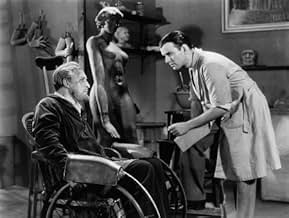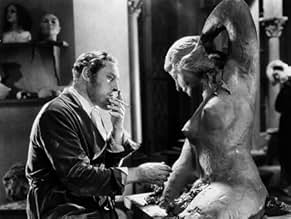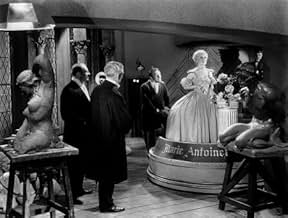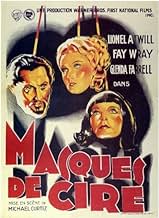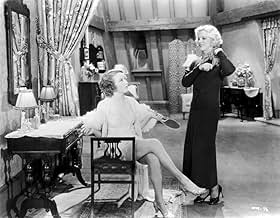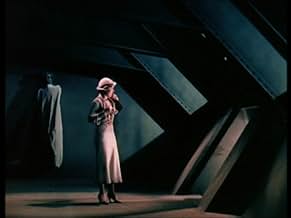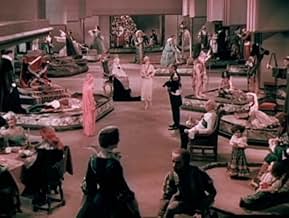PUNTUACIÓN EN IMDb
6,8/10
7,3 mil
TU PUNTUACIÓN
En un museo de cera, un curador enmascarado transforma a la gente en estatuas y busca a su siguiente María Antonieta.En un museo de cera, un curador enmascarado transforma a la gente en estatuas y busca a su siguiente María Antonieta.En un museo de cera, un curador enmascarado transforma a la gente en estatuas y busca a su siguiente María Antonieta.
- Dirección
- Guión
- Reparto principal
Thomas E. Jackson
- Detective
- (as Thomas Jackson)
Bull Anderson
- Janitor
- (sin acreditar)
Frank Austin
- Winton's Valet
- (sin acreditar)
Max Barwyn
- Museum Visitor
- (sin acreditar)
Wade Boteler
- Ambrose
- (sin acreditar)
Reseñas destacadas
Considering the fact that this 1933 movie was produced during the depression, when moviegoers expected pure entertainment, the results were exactly what they wanted. Glenda Farrell's hard-boiled Florence Dempsey was what filmgoers were looking for. Please note that many of the movies of the period had male and female stars who were fast talkers and wise-crackers. Such stars as Cary Grant, Carole Lombard, Rosalind Russell, Bette Davis, James Cagney, Mae West, W. C. Fields, William Powell, Myrna Loy, etc. were the norm and not the exception.
This wonderful movie was way ahead of its time. It's two-color look was also something very different for the 1930s and its washed-out looked helped give it a more sinister appearance. The later "House of Wax" used 3-D and having seen it in the movies I can tell you it was probably the best of the 3-D movies. Even better than "The Creature from the Black Lagoon".
Fay Wray was pure candy and she practiced her scream well for the upcoming "King Kong". I have seen most of Lionel Atwill's work and I believe the underplaying of Ivan Igor helped make him a more credible monster. The movie was well cast and one can not help but notice the uncanny fact that most of the actors in "The House of Wax" were chosen because they looked like the earlier actors except for the difference between Charles Buchinsky (Bronson) and Matthew Betz as the loyal mute assistant.
Although enjoyable, "The House of Wax" was no match for the earlier edition. It's understandable that "The House of Wax" did not use the characters of Florence Dempsey and Gavin Gordon. Sidekicks didn't work as well as in the 50s.
I wonder what the movie critics of the 30s thought of the "Mystery of the Wax Museum?"
This wonderful movie was way ahead of its time. It's two-color look was also something very different for the 1930s and its washed-out looked helped give it a more sinister appearance. The later "House of Wax" used 3-D and having seen it in the movies I can tell you it was probably the best of the 3-D movies. Even better than "The Creature from the Black Lagoon".
Fay Wray was pure candy and she practiced her scream well for the upcoming "King Kong". I have seen most of Lionel Atwill's work and I believe the underplaying of Ivan Igor helped make him a more credible monster. The movie was well cast and one can not help but notice the uncanny fact that most of the actors in "The House of Wax" were chosen because they looked like the earlier actors except for the difference between Charles Buchinsky (Bronson) and Matthew Betz as the loyal mute assistant.
Although enjoyable, "The House of Wax" was no match for the earlier edition. It's understandable that "The House of Wax" did not use the characters of Florence Dempsey and Gavin Gordon. Sidekicks didn't work as well as in the 50s.
I wonder what the movie critics of the 30s thought of the "Mystery of the Wax Museum?"
Michael Curtiz has over 170 directing credits, including "The Jazz Singer." Of the films on that list which I have seen, this is my favourite. It's filled with some quite amazing dolly and camera work, the story is fun and the acting is solid.
This story has had a long life. This film, was based on a play. In 1953, it was re-made as a Vincent Price vehicle, "House of Wax" in 3-D. And in 2005, it was re-made again as a teen slasher. The premise is solidly creepy.
Glenda Farrell is hilarious as the young journalist. Her energy leaps off the screen. I guess audiences of 1933 needed quite a bit of comic relief to make it through the rest of this.
Lionel Atwill's make-up is fantastic. It's no surprise that it was designed by a Westmore: Hollywood's premiere make-up family.
This was shot in a two-colour Technicolor process which makes the entire film rather distinctive and moody. The fantastic film noir lighting adds to it as well.
If you can find this, it's a definite must-see! There are so many images and ideas borrowed from it in later horror films it's interesting to see their origins.
This story has had a long life. This film, was based on a play. In 1953, it was re-made as a Vincent Price vehicle, "House of Wax" in 3-D. And in 2005, it was re-made again as a teen slasher. The premise is solidly creepy.
Glenda Farrell is hilarious as the young journalist. Her energy leaps off the screen. I guess audiences of 1933 needed quite a bit of comic relief to make it through the rest of this.
Lionel Atwill's make-up is fantastic. It's no surprise that it was designed by a Westmore: Hollywood's premiere make-up family.
This was shot in a two-colour Technicolor process which makes the entire film rather distinctive and moody. The fantastic film noir lighting adds to it as well.
If you can find this, it's a definite must-see! There are so many images and ideas borrowed from it in later horror films it's interesting to see their origins.
A genuinely frightening film from Michael Curtiz, jack of no trades and master of all. Many of the tricks of classic 1930's horror are here, including the opening scene set in a dark, rainy London street, the long shadows on the wall, lengthy periods of silence, and all timed to perfection. Only the faster-than-the-speed-of-sound dialogue of Glenda Farrell truly lets the film down. But other than that it is a gothic masterpiece, an underrated movie probably due to the fact that it lay undiscovered, thought lost, for over half a century. Far more inventive and imaginative than the majority of horror films made today.
This film, which was remade as "House Of Wax" 20 years later (as if you didn't know), might not enjoy quite the reputation it does today had it not been the basis for the better-known later film and, more importantly, believed lost for over 30 years, which made it something of a legend for many people who'd never even seen it. Legendary status can be rather difficult to live up to, and unless a viewer is approaching it with no advance knowledge of its history, MYSTERY OF THE WAX MUSEUM may not be quite what one expects.
It is, nevertheless, an energetic and entertaining amalgam of genres: horror film meets newspaper crime drama. Dropping a rather Gothic tale of body-snatching, a mad sculptor and a museum of wax-covered corpses into the streamline-moderne milieu of fast-talking, wise-cracking reporters on the trail of a hot story makes for interesting contrasts.
Lionel Atwill, as Ivan Igor, the artist driven to insanity and murder by the destruction of his wax "children" in an arson fire, was an immensely enjoyable performer whose best work came a bit later (see "Son Of Frankenstein" for his portrayal of the one-armed Insp. Krogh). His natural screen presence carries him through, though he never quite generates either the pathos or the smooth menace that Vincent Price displayed in the remake. But from the moment of her entrance, it's Glenda Farrell as Florence Dempsey, the reporter out to save her job by bringing in a scoop - barreling onto the screen with a full head of steam - who propels the story all the way to its finish.
There's an awful lot going on here beyond the basic premise; bootlegging, a "dope fiend," a suicide and a falsely implicated millionaire playboy are thrown into the mix, packing quite a lot into the 77 minute running time (the remake improved the story by eliminating extraneous characters and subplots). A pre-"King Kong" Fay Wray (in her naturally red hair sans the "Kong" blond wig) is the damsel in actual distress, but despite her billing, she's basically a supporting player and has little to do - beyond enduring roommate Florence's snide comments about her penniless boyfriend - until the climactic confrontation between all the bad guys and good guys (and girls).
MYSTERY is well-served by the direction of Michael Curtiz ("Adventures Of Robin Hood," "Casablanca"), who was something of a jack-of-all-genres, and there's plenty of snappy dialogue, some of which (Florence asking a cop, "How's your sex life?") wouldn't have made it to the screen a year later under the newly re-written Production Code. Depending on one's point of view, it could be said that the very effective production design either benefits, or suffers, from the pale pastels of the two-strip Technicolor photography. For my part, I'm guessing that the subdued tones we see today result from the lack of first-rate film elements available. Having seen far superior two-strip from years earlier, I'll wager that the original prints were much more vivid.
If you're any kind of a fan of the remake, you do owe it to yourself to see this one, if only once. There are many things to enjoy in MYSTERY OF THE WAX MUSEUM, not the least of which are the fabulous ensembles worn by Farrell. Just how does a newspaper reporter one step away from the breadline afford a wardrobe like that?
It is, nevertheless, an energetic and entertaining amalgam of genres: horror film meets newspaper crime drama. Dropping a rather Gothic tale of body-snatching, a mad sculptor and a museum of wax-covered corpses into the streamline-moderne milieu of fast-talking, wise-cracking reporters on the trail of a hot story makes for interesting contrasts.
Lionel Atwill, as Ivan Igor, the artist driven to insanity and murder by the destruction of his wax "children" in an arson fire, was an immensely enjoyable performer whose best work came a bit later (see "Son Of Frankenstein" for his portrayal of the one-armed Insp. Krogh). His natural screen presence carries him through, though he never quite generates either the pathos or the smooth menace that Vincent Price displayed in the remake. But from the moment of her entrance, it's Glenda Farrell as Florence Dempsey, the reporter out to save her job by bringing in a scoop - barreling onto the screen with a full head of steam - who propels the story all the way to its finish.
There's an awful lot going on here beyond the basic premise; bootlegging, a "dope fiend," a suicide and a falsely implicated millionaire playboy are thrown into the mix, packing quite a lot into the 77 minute running time (the remake improved the story by eliminating extraneous characters and subplots). A pre-"King Kong" Fay Wray (in her naturally red hair sans the "Kong" blond wig) is the damsel in actual distress, but despite her billing, she's basically a supporting player and has little to do - beyond enduring roommate Florence's snide comments about her penniless boyfriend - until the climactic confrontation between all the bad guys and good guys (and girls).
MYSTERY is well-served by the direction of Michael Curtiz ("Adventures Of Robin Hood," "Casablanca"), who was something of a jack-of-all-genres, and there's plenty of snappy dialogue, some of which (Florence asking a cop, "How's your sex life?") wouldn't have made it to the screen a year later under the newly re-written Production Code. Depending on one's point of view, it could be said that the very effective production design either benefits, or suffers, from the pale pastels of the two-strip Technicolor photography. For my part, I'm guessing that the subdued tones we see today result from the lack of first-rate film elements available. Having seen far superior two-strip from years earlier, I'll wager that the original prints were much more vivid.
If you're any kind of a fan of the remake, you do owe it to yourself to see this one, if only once. There are many things to enjoy in MYSTERY OF THE WAX MUSEUM, not the least of which are the fabulous ensembles worn by Farrell. Just how does a newspaper reporter one step away from the breadline afford a wardrobe like that?
She has been so sorely maligned. Despite what has been claimed by others here, Glenda Farrell was not a bad actress. A little broad sometimes perhaps, but not bad. She is a dynamo of live energy, which the film badly needs, for the only other energetic character in the film is Atwill, and only Farrell has the force to bring him down(that the script does not let her do so personally betrays the character). It is not Farrell's performance or even her character which is the problem of the film, but the script which makes that character necessary. Chock Full O' undeveloped characters (only Atwill and Farrell qualify as more than ciphers)whose paths cross coincidentally,Farrell's reporter is the one in the middle bringing the disparate elements together. A reporter or policeman had to be the central character, for only one of those two would be privy to all or even enough of the info needed to solve the puzzle, or to even recognize that the puzzle existed. And only a female reporter could be Fay Wray's roommate, as female police detectives or beat cops didn't exist(at least not in Hollywood). And only a fast-talking, wisecracking, brash and fierce female reporter able to beat the stereotypical fast-talking, wisecracking, brash 1930's male reporter at his own game could find the story AND crack the case before the police. Others have objected to the attention given the comic relief, apparently misunderstanding the term. Comic relief characters are supporting characters, and in this film, despite third billing, Glenda Farrell is the female lead. Fay Wray was a freelancer and able to negotiate better billing even though her role doesn't deserve it. Had she not had a real lead in the companion film DR.X, it's unlikely she would have been asked to take such a small part. Charlotte is needed in the story only for a face, and her face and scream are all Wray is allowed to bring to the role. As outstanding as those two attributes are, they don't add up to a real character. And while Farrell cracks wise, she is doing serious work central to the tale. A role with comedic content is not automatically a comic relief part. The script is a mess, letting down the great concept. HOUSE OF WAX is a much tighter script, more linear, combining ingenue and snoop into one role, and beefing up the part of the disfigured sculptor. It drops the very extraneous playboy character and the loose ends which trail in his wake. But most agree that HOUSE is boring compared to MYSTERY, and in addition to the direction and editing, much of MYSTERY's drive comes from the girl reporter and the crack actress who played her. Even if you do find her grating, Glenda Farrell is never boring.
¿Sabías que...?
- CuriosidadesThis film was produced before the Production Code. When it was remade 20 years later, as Los crímenes del museo de cera (1953), all references to drug use were removed, and a character was changed from a junkie to an alcoholic.
- PifiasIvan Igor says that Jean Paul Marat's assassin, Charlotte Corday, was his mistress. This is incorrect; they never had met until she came to his office posing as a courier and quickly stabbed him to death. After her execution a few days later, she was found to be virgo intacta.
- Versiones alternativasThis film was shot in two versions. One camera unit shot the film in two-color Technicolor. A second camera unit shot the scenes at the same time in black and white. The black and white version was meant for theaters who could not afford the higher rental cost of the color prints.
- ConexionesEdited into Ante todo, mujer (1974)
Selecciones populares
Inicia sesión para calificar y añadir a tu lista para recibir recomendaciones personalizadas
Detalles
- Duración1 hora 17 minutos
- Relación de aspecto
- 1.37 : 1
Contribuir a esta página
Sugerir un cambio o añadir el contenido que falta


